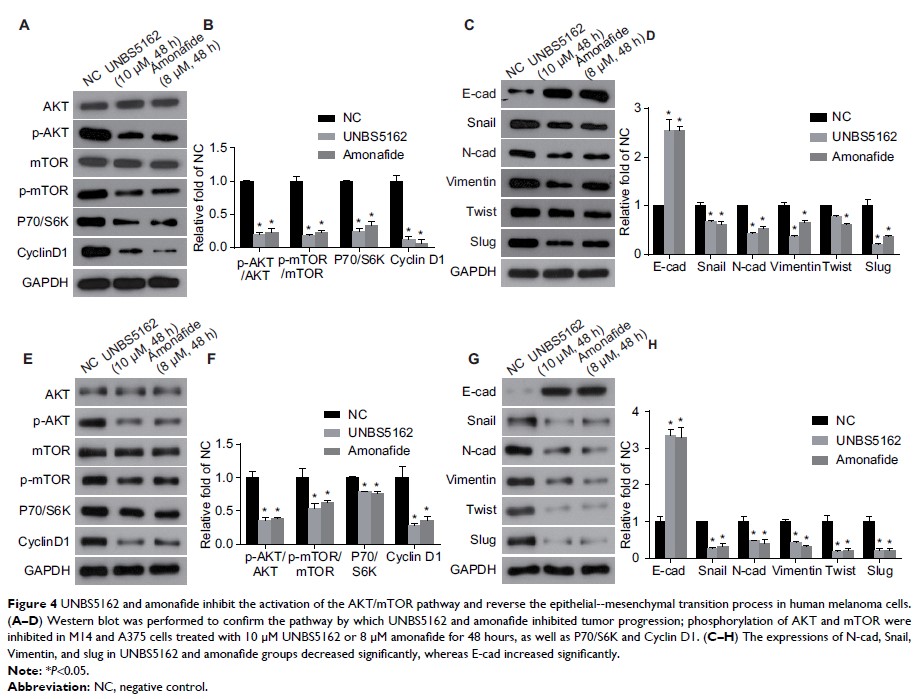9 7 8 1 6
论文已发表
注册即可获取德孚的最新动态
IF 收录期刊
- 3.3 Breast Cancer (Dove Med Press)
- 3.4 Clin Epidemiol
- 2.5 Cancer Manag Res
- 2.9 Infect Drug Resist
- 3.5 Clin Interv Aging
- 4.7 Drug Des Dev Ther
- 2.7 Int J Chronic Obstr
- 6.6 Int J Nanomed
- 2.5 Int J Women's Health
- 2.5 Neuropsych Dis Treat
- 2.7 OncoTargets Ther
- 2.0 Patient Prefer Adher
- 2.3 Ther Clin Risk Manag
- 2.5 J Pain Res
- 2.8 Diabet Metab Synd Ob
- 2.8 Psychol Res Behav Ma
- 3.0 Nat Sci Sleep
- 1.8 Pharmgenomics Pers Med
- 2.7 Risk Manag Healthc Policy
- 4.2 J Inflamm Res
- 2.1 Int J Gen Med
- 4.2 J Hepatocell Carcinoma
- 3.7 J Asthma Allergy
- 1.9 Clin Cosmet Investig Dermatol
- 2.7 J Multidiscip Healthc

UNBS5162 和 amonafide 通过 AKT/mTOR 信号通路抑制人黑素瘤的肿瘤进展
Authors Ye Y, Huang S, Wu Y
Received 19 June 2018
Accepted for publication 25 January 2019
Published 22 March 2019 Volume 2019:11 Pages 2339—2348
DOI https://doi.org/10.2147/CMAR.S177623
Checked for plagiarism Yes
Review by Single-blind
Peer reviewers approved by Dr Justinn Cochran
Peer reviewer comments 3
Editor who approved publication: Professor Nakshatri
Background: Human
melanoma is a malignant tumor originated from melanocytes with high invasion,
metastasis, and poor prognosis. In this study, the effects of naphthalimides
UNBS5162 and amonafide on the properties of proliferation and apoptosis in
human melanoma cells were confirmed.
Methods: Cell
proliferation was determined by CCK8 and clone formation assay. Transwell assay
was performed to detect the migration and invasion of M14 and A375 cells. Cell
apoptosis was estimated using flow cytometry.
Results: In a drug
sensitivity assay, cell viability decreased with increasing concentrations of
UNBS5162 or amonafide. Likewise, proliferation of M14 or A375 cells treated
with 10 μM UNBS5162 or 8 μM amonafide decreased significantly when compared
with negative control (NC) cells, their inhibition effect verified by means of
a clone formation assay. After the treatment with UNBS5162 or amonafide, the
migration of melanoma cells was inhibited in a dosedependent manner. The number
of invaded cells treated with UNBS5162 was also significantly reduced when
compared with those of the NC cells. The apoptotic cell numbers treated with
UNBS5162 or amonafide decreased significantly when compared with the M14 and
A375 cells in the NC group. According to Western blot results, phosphorylation
of AKT and expressions of mesenchymal marker factors were inhibited in cells treated
with UNBS5162 or amonafide.
Conclusion: These
results reveal that UNBS5162 inhibits the cell activity of melanoma cells
through the AKT/mTOR signaling pathway, and reverses epithelial–mesenchymal
transition conversion in human melanoma cells. This study on UNBS5162 and
amonafide in melanomas provides an experimental basis of their uses and
potential value on human melanoma treatment.
Keywords: cell
apoptosis, proliferation, M14, A375, epithelial-mesenchymal transition
